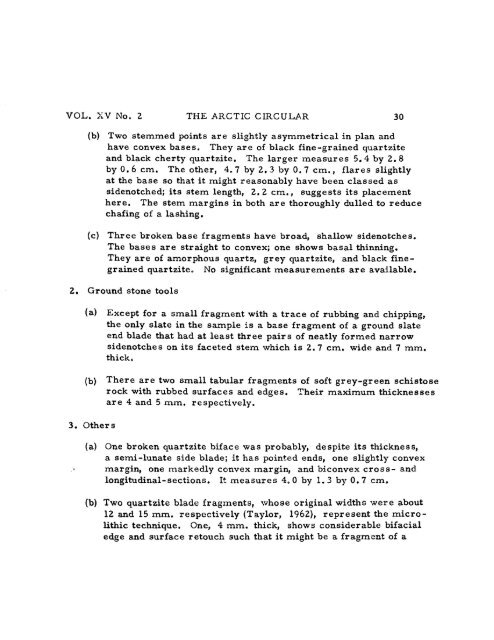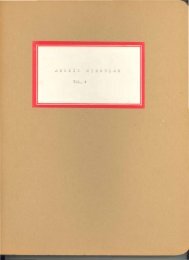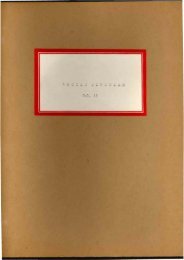A RCTIC CIRCULA NO. I Notes on a trip in l6-foot ... - The Arctic Circle
A RCTIC CIRCULA NO. I Notes on a trip in l6-foot ... - The Arctic Circle
A RCTIC CIRCULA NO. I Notes on a trip in l6-foot ... - The Arctic Circle
You also want an ePaper? Increase the reach of your titles
YUMPU automatically turns print PDFs into web optimized ePapers that Google loves.
VOL. XV No" Z THE A<str<strong>on</strong>g>RCTIC</str<strong>on</strong>g> <str<strong>on</strong>g>CIRCULA</str<strong>on</strong>g>R<br />
(b) Two stemmed po<strong>in</strong>ts are slightly asymmetrical <strong>in</strong> plan and<br />
have c<strong>on</strong>vex bases. <strong>The</strong>y are of black f<strong>in</strong>e-gra<strong>in</strong>ed quartzite<br />
and black cherty quartzite. <strong>The</strong> larger measures 5. 4 by ?,.8<br />
by 0.6 cm. <strong>The</strong> other, 4,1 by 2,3 by 0. ? cm., flares slightly<br />
at the base so that it rnight reas<strong>on</strong>ably have been classed as<br />
sidenotched; its stem length, 2.7 crn.., suggests its placement<br />
here. <strong>The</strong> stem marg<strong>in</strong>s <strong>in</strong> both are thoroughly dulled to reduce<br />
chaf<strong>in</strong>g af a lash<strong>in</strong>g.<br />
(c) Three broken base fragments have broad, sballow sidenotches.<br />
<strong>The</strong> bases are straight to c<strong>on</strong>vex; <strong>on</strong>e shows basal tb<strong>in</strong>n<strong>in</strong>g.<br />
<strong>The</strong>y are of amorphous quartz, grey quartzite, and black f<strong>in</strong>egra<strong>in</strong>ed<br />
quartzite. No significant measurenx,eats are available.<br />
2, Ground st<strong>on</strong>e tools<br />
(a) Except for a small fragrnent with a trace of rubb<strong>in</strong>g and chipp<strong>in</strong>g,<br />
the <strong>on</strong>ly slate <strong>in</strong> the sample is a base fragment of a ground slate<br />
end blade that had at least three pairs of neatly formed narrow<br />
sidenotches <strong>on</strong> its faceted stem which is 2. ? crn. wide and ? mm.<br />
thick.<br />
(b) <strong>The</strong>re are two small tabular fragments of soft grey-greea schistose<br />
rock witb rubbed eurfaces and edges. <strong>The</strong>ir maximum thicknesses<br />
are 4 and 5 mm. respectively.<br />
3. Other s<br />
(a)<br />
(b)<br />
Cne broken quartzite biface was probably, despite its thickness,<br />
a semi-lunate side blade; it has po<strong>in</strong>ted ends, <strong>on</strong>e slightly c<strong>on</strong>vex<br />
marg<strong>in</strong>, <strong>on</strong>e markedly c<strong>on</strong>vex marg<strong>in</strong>, and bic<strong>on</strong>vex cross- and<br />
l<strong>on</strong>gihrd,<strong>in</strong>al-gecti<strong>on</strong>s. It measures 4.0 by I,3 by 0.7 cm,<br />
Two quartzite blade fragments, rvhose orig<strong>in</strong>al widths were about<br />
12 and 15 mm. r€spectively (Taylor, 19621, represent the micro-<br />
Lithic technique, One, 4 mm. thick, shows c<strong>on</strong>siderable bifacial<br />
edge and surface retouch euch that it might be a fragmeut of a<br />
30












